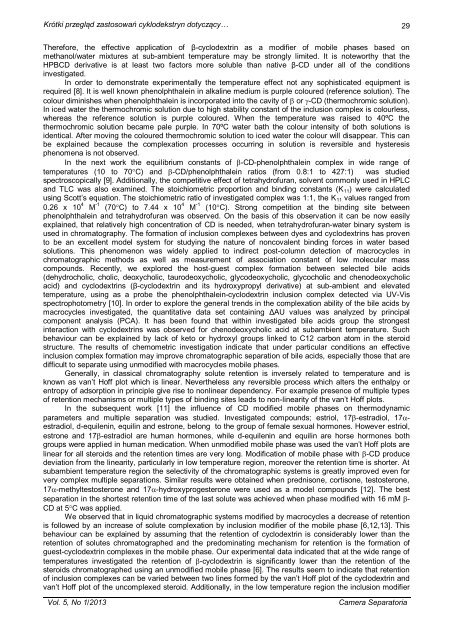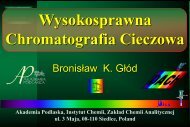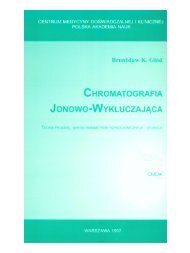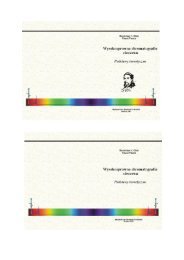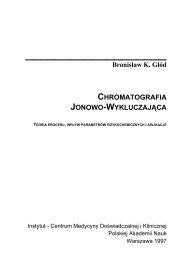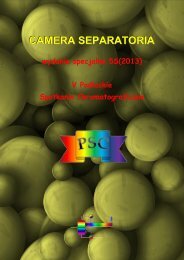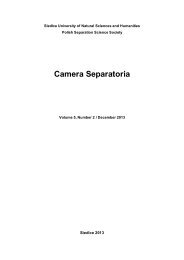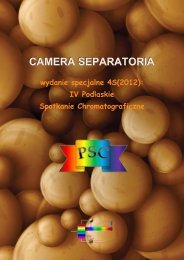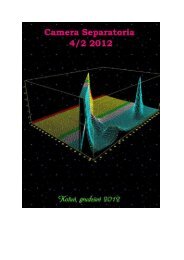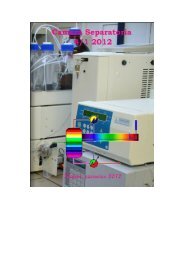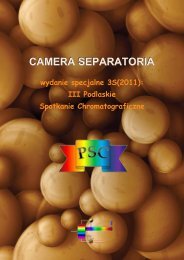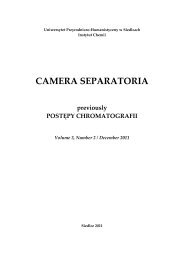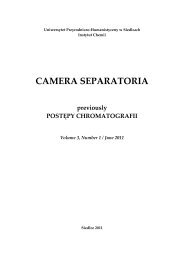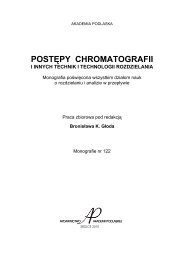CamSep 5 1
Create successful ePaper yourself
Turn your PDF publications into a flip-book with our unique Google optimized e-Paper software.
Krótki przegląd zastosowań cyklodekstryn dotyczący…<br />
29<br />
Therefore, the effective application of β-cyclodextrin as a modifier of mobile phases based on<br />
methanol/water mixtures at sub-ambient temperature may be strongly limited. It is noteworthy that the<br />
HPBCD derivative is at least two factors more soluble than native β-CD under all of the conditions<br />
investigated.<br />
In order to demonstrate experimentally the temperature effect not any sophisticated equipment is<br />
required [8]. It is well known phenolphthalein in alkaline medium is purple coloured (reference solution). The<br />
colour diminishes when phenolphthalein is incorporated into the cavity of or -CD (thermochromic solution).<br />
In iced water the thermochromic solution due to high stability constant of the inclusion complex is colourless,<br />
whereas the reference solution is purple coloured. When the temperature was raised to 40ºC the<br />
thermochromic solution became pale purple. In 70ºC water bath the colour intensity of both solutions is<br />
identical. After moving the coloured thermochromic solution to iced water the colour will disappear. This can<br />
be explained because the complexation processes occurring in solution is reversible and hysteresis<br />
phenomena is not observed.<br />
In the next work the equilibrium constants of -CD-phenolphthalein complex in wide range of<br />
temperatures (10 to 70C) and -CD/phenolphthalein ratios (from 0.8:1 to 427:1) was studied<br />
spectroscopically [9]. Additionally, the competitive effect of tetrahydrofuran, solvent commonly used in HPLC<br />
and TLC was also examined. The stoichiometric proportion and binding constants (K 11 ) were calculated<br />
using Scott’s equation. The stoichiometric ratio of investigated complex was 1:1, the K 11 values ranged from<br />
0.26 x 10 4 M -1 (70C) to 7.44 x 10 4 M -1 (10C). Strong competition at the binding site between<br />
phenolphthalein and tetrahydrofuran was observed. On the basis of this observation it can be now easily<br />
explained, that relatively high concentration of CD is needed, when tetrahydrofuran-water binary system is<br />
used in chromatography. The formation of inclusion complexes between dyes and cyclodextrins has proven<br />
to be an excellent model system for studying the nature of noncovalent binding forces in water based<br />
solutions. This phenomenon was widely applied to indirect post-column detection of macrocycles in<br />
chromatographic methods as well as measurement of association constant of low molecular mass<br />
compounds. Recently, we explored the host-guest complex formation between selected bile acids<br />
(dehydrocholic, cholic, deoxycholic, taurodeoxycholic, glycodeoxycholic, glycocholic and chenodeoxycholic<br />
acid) and cyclodextrins (β-cyclodextrin and its hydroxypropyl derivative) at sub-ambient and elevated<br />
temperature, using as a probe the phenolphthalein-cyclodextrin inclusion complex detected via UV-Vis<br />
spectrophotometry [10]. In order to explore the general trends in the complexation ability of the bile acids by<br />
macrocycles investigated, the quantitative data set containing ΔAU values was analyzed by principal<br />
component analysis (PCA). It has been found that within investigated bile acids group the strongest<br />
interaction with cyclodextrins was observed for chenodeoxycholic acid at subambient temperature. Such<br />
behaviour can be explained by lack of keto or hydroxyl groups linked to C12 carbon atom in the steroid<br />
structure. The results of chemometric investigation indicate that under particular conditions an effective<br />
inclusion complex formation may improve chromatographic separation of bile acids, especially those that are<br />
difficult to separate using unmodified with macrocycles mobile phases.<br />
Generally, in classical chromatography solute retention is inversely related to temperature and is<br />
known as van’t Hoff plot which is linear. Nevertheless any reversible process which alters the enthalpy or<br />
entropy of adsorption in principle give rise to nonlinear dependency. For example presence of multiple types<br />
of retention mechanisms or multiple types of binding sites leads to non-linearity of the van’t Hoff plots.<br />
In the subsequent work [11] the influence of CD modified mobile phases on thermodynamic<br />
parameters and multiple separation was studied. Investigated compounds; estriol, 17-estradiol, 17estradiol,<br />
d-equilenin, equilin and estrone, belong to the group of female sexual hormones. However estriol,<br />
estrone and 17-estradiol are human hormones, while d-equilenin and equilin are horse hormones both<br />
groups were applied in human medication. When unmodified mobile phase was used the van’t Hoff plots are<br />
linear for all steroids and the retention times are very long. Modification of mobile phase with -CD produce<br />
deviation from the linearity, particularly in low temperature region, moreover the retention time is shorter. At<br />
subambient temperature region the selectivity of the chromatographic systems is greatly improved even for<br />
very complex multiple separations. Similar results were obtained when prednisone, cortisone, testosterone,<br />
17-methyltestosterone and 17-hydroxyprogesterone were used as a model compounds [12]. The best<br />
separation in the shortest retention time of the last solute was achieved when phase modified with 16 mM -<br />
CD at 5C was applied.<br />
We observed that in liquid chromatographic systems modified by macrocycles a decrease of retention<br />
is followed by an increase of solute complexation by inclusion modifier of the mobile phase [6,12,13]. This<br />
behaviour can be explained by assuming that the retention of cyclodextrin is considerably lower than the<br />
retention of solutes chromatographed and the predominating mechanism for retention is the formation of<br />
guest-cyclodextrin complexes in the mobile phase. Our experimental data indicated that at the wide range of<br />
temperatures investigated the retention of -cyclodextrin is significantly lower than the retention of the<br />
steroids chromatographed using an unmodified mobile phase [6]. The results seem to indicate that retention<br />
of inclusion complexes can be varied between two lines formed by the van’t Hoff plot of the cyclodextrin and<br />
van’t Hoff plot of the uncomplexed steroid. Additionally, in the low temperature region the inclusion modifier<br />
Vol. 5, No 1/2013<br />
Camera Separatoria


